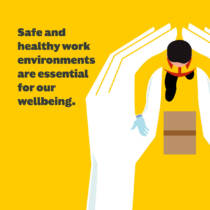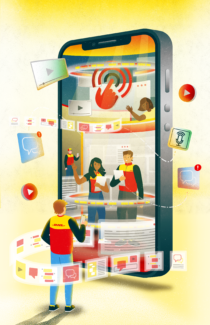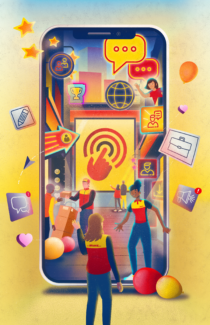Creating a more neuroinclusive work environment
By Sally Pritchett
CEO
With many citing empowering neurodivergent talent as a business imperative, discover how your workforce can behave in a more neuroinclusive way.
Embracing neurodiversity within your workforce can introduce fresh perspectives, new ways of thinking, and innovative ideas. According to Deloitte, “organizations that make an extra effort to recruit, retain, and nurture neurodivergent workers can gain a competitive edge from increased diversity in skills, ways of thinking, and approaches to problem-solving.”
With studies showing that an estimated 15-20% of adults are neurodivergent, businesses that neglect to take measures to recognise, embrace and support people who are neurodiverse, risk being left behind.
Neurodiversity isn’t a superpower. However, by empowering a diverse workforce, and creating a workplace environment where everyone feels understood and accepted, employees can feel psychologically safer and more able to share different perspectives and approaches.
There are some simple steps we can encourage employees to take to better support their neurodiverse colleagues.
So, what steps can we give our teams to help them work in a more neuroinclusive way?
In an office environment…
Reduce office overstimulation
Think about a typical office environment – bright lights, unexpected noises, different smells, lots of people moving around. This can make offices very overstimulating for many people. Consider ways you can help reduce office overstimulation. This could involve encouraging team members to take calls and eat their lunch away from the main office area, or to use headphones when watching videos.
Respect quiet spaces
If someone takes themselves away from a main office space to work it may be that they are looking for a quieter environment to focus. When someone seeks a quieter space to work, ask your team to consider popping over a quick message asking for a discussion or scheduling a dedicated time to talk.
When sharing information or tasks…
Give specific instructions
Don’t expect people to read between the lines. It can be very difficult for someone to pinpoint exactly what they need to do or achieve if they are not given specific instructions. Encourage clear and direct communication.
Avoid unclear information
We like the ‘What you need, by when, and why’ basis for giving them instructions , shared by Ellie Middleton in her highly recommended Nano Tips for Working Inclusively with Neurodivergent Employees LinkedIn Learning course. Saying things like ‘this is urgent’ but without clearer instructions can be overwhelming, as people’s perceptions of urgency can be different. Encourage your team to provide clear timeframes to help colleagues plan their time accordingly or rearrange tasks if needed.
Keep everyone on the same page
Have all processes and policies written down so that everyone has access to clear guidelines. Ensure that everyone knows where and how to access these processes and policies so they can refer to them as they need to.
Make information available
Neurodivergent people can become overwhelmed by not having enough information. Make sure all the details people could need in the workplace or for specific tasks are accessible. It can also help to provide people with the opportunity to ask for further information if they require it.
When working together…
Adapt communication styles
We all communicate with one another in different ways, and some people feel more confident expressing themselves through specific methods of communication. Encourage your team to tune in to and understand each other’s preferred ways of communicating, and adapt to these styles where possible. For example, when asking for ideas or feedback in a meeting, you could also give people an opportunity to share their thoughts via email after the discussion.
Embrace diverse work styles
It’s important to recognise and appreciate that people have varied work rhythms. By focusing on outcomes, instead of the way someone reaches that outcome, people can feel more comfortable working in a way that helps them deliver their best work.
Share information early
Help everyone prepare by always sharing meeting agendas and information in advance. This gives people a chance to digest the information they need to understand and feel comfortable and confident when they get into a meeting.
Pop over a message before calls
Unexpected calls or meetings can disrupt people or cause them to feel unprepared for or anxious about the incoming call. Suggest that colleagues send a quick message before making calls to help ensure a productive conversation, and give people time to prepare for and get into the right mindset for the call.
Neuroinclusion benefits everyone
As we’ve discussed, diversity brings new perspectives and ways of thinking about things. Better support of neurodivergent people can help us all to access different perspectives and approaches. A neuroinclusive environment nurtures a culture of empathy and acceptance, enhancing the workplace and strengthening teamwork.
However, reading through these tips you may have felt that they are really just some best practice and sensible suggestions on ways of working with other people. Neuroinclusive practices foster clearer communication, patience, and understanding among all team members – both neurodivergent and neurotypical. An inclusive approach paves the way for better interactions and collaboration, benefiting everyone.
Are you ready to talk about neuroinclusion?
If you want to start the conversation about neuroinclusive working with your employees, get in touch as we can support you with creating engaging communications that help nurture an inclusive workplace culture.
5 trends that we expect will shape workplace culture in 2024
By Sally Pritchett
CEO
Curious about the evolving workplace culture in 2024? Explore these five key employee priorities.
Workplace culture has a profound impact on employee engagement, productivity, and morale, so organisations must keep up with what is important to employees to help nurture a positive environment. With 45% of UK employees saying a great culture is the most important factor when looking for a new job, what should employers be looking out for in 2024?
1. Flexibility will continue to be key
The pandemic changed the way many of us work, driving a surge in the number of employees working from home. In 2023, some companies continued with fully remote working, whereas others have started to implement return-to-office policies and hybrid work options. But what could happen in 2024?
We expect to see more of a shift towards employees wanting flexibility, rather than just the opportunity to work from home. With 71% of workers saying a flexible working pattern is important to them when considering a new role, this suggests employees are looking for flexibility around arrangements such as start and finish times or where they work from too, to help them achieve a better work-life balance.
2. Prioritising employee mental health and wellbeing
We believe nurturing a healthy culture that supports employee mental health and wellbeing is one of the biggest areas of importance for 2024. In 2020-2021 alone, .
Although the effect of not prioritising employee wellbeing on productivity is clear, nurturing a healthy workplace culture is about much more than just the financial impact. In a workplace where wellbeing is prioritised, there is likely to be higher employee morale, reduced turnover, and increased job satisfaction.
3. The demand for sustainability
With Gen Z joining the workforce, they are beginning to influence workplace culture. By 2025, Gen Z will account for 27% of the workforce, so employers will need to start listening to what’s important to them if they wish to attract and retain the next generation of talent.
With 50% of Gen Zs saying they are pushing their employer to drive change on environmental issues, it’s clear that sustainability is an important matter that employers need to prioritise as part of their workplace culture initiatives. However, as well as businesses looking at organisational sustainability initiatives, part of building an environmentally conscious workplace culture involves supporting and empowering employees to make better choices in their lives outside of work.
4. Employees want to feel a sense of belonging
This year, diversity, equity and inclusion have become increasingly important in the workplace. In 2024, the focus on DEIB is set to continue. 65% of employees admit they want to feel a strong sense of belonging at work, suggesting employers need to start going further than just having a DEIB policy.
Many employees now want to feel like part of a community at work, form stronger connections with colleagues, and feel like they can be their true selves at work. To help nurture this type of culture, employers need to ensure their DEIB initiatives are accessible, thorough, and most importantly, authentic.
5. The importance of internal communications
Internal communications help keep employees informed, engaged and connected to a business. However, effective internal communications are about more than just sending out a monthly email newsletter to employees. There are many channels that employers can, and should, use to keep employees engaged with the business. This is particularly important for reaching frontline workers, where email isn’t necessarily the best way to communicate with the workforce.
As we approach 2024, nurturing a healthy, safe and thriving workplace culture has never been more important. If you’re looking for some support in developing internal communications strategies or initiatives that engage your workforce, we’re here to help.
Attract and retain top talent: the power of purpose and culture
By Sally Pritchett
CEO
When culture, honest communication, and purpose are essential, how can communicators attract and retain top talent?
Ever find yourself lost in the hustle, wondering where all your time goes? The busier life gets, the more crucial it becomes to reflect on how we spend our time. After all, time is precious, and optimising it is an art.
In a video earlier this year, our Commercial Director reflected on the time they had devoted to a battle they know all too well – the Talent War. To be exact, 650+ hours in 2022 alone, navigating the competitive landscape of recruitment, CVs, interviews, and the rollercoaster of onboarding and, unfortunately, occasional offboarding.
While some say the Talent War is over due to economic instability, the truth is that many employees are still seeking purpose in their work. Moreover, the growing differences in generational expectations regarding the workplace is creating challenges in attracting, and retaining, top talent. These shifts show that finding and keeping top talent goes beyond just economic factors.
When workplace culture, honest communications, and company purpose are vital to today’s employees, what can communicators do to attract and retain top talent?
Engage with hearts and minds
Attracting talent boils down to one thing: opening and engaging with the hearts and minds of potential candidates. Let’s take a trip back to 2001 when Apple revolutionised the music industry with the iPod. What set it apart wasn’t specs and features but the simplicity and clarity of its message – “1,000 songs in your pocket.” In today’s competitive job market, what’s your unique selling proposition? Flexible working, competitive salaries, and employee benefits while all essential to many job seekers, don’t define a company in the long run.
The power of purpose
The key to success? Define what sets your company apart, and that comes down to your company’s purpose. Employee motivations are evolving, and companies addressing this shift are few and far between. People crave purpose in their work. Statistics show 75% of the workforce will be ethically-minded millennials by 2025. Placing purpose front and centre, and integrating it into job descriptions and candidate discussions can help you connect with the right candidates and sidestep those where synergy is lacking.
Building a magnetic culture
It costs to attract, engage, and grow your people. The solution? Building a magnetic culture. A business with a magnetic culture draws people in, creates unity, and retains the best talent. And a thriving culture boosts productivity, improves customer service, and reduces turnover costs. In retention, go beyond the basics.
Be like Apple – stand apart. Focus on creating a thriving culture, driven by your purpose, to make your business different.
Whether you’re refreshing your recruitment communications or nurturing a united workplace culture, we can provide the support you need.
How to cultivate a safety-first culture
By Sally Pritchett
CEO
How to sustain a safety-first culture across large organisations
Safe and healthy work environments are essential for our wellbeing. When we feel physically and psychologically safe at work, we are more likely to feel engaged, motivated and can thrive in our roles.
To maintain a safe workplace, businesses need to ensure that employees always keep health & safety guidance front of mind. Yet it can be difficult to ensure that more educational, safety-focused messaging cuts through the noise of other internal comms, especially across large organisations.
It’s also important that health & safety communications are inclusive to ensure that the message reaches every person in the organisation. Businesses need to use plain, accessible language that is easy to understand, but still be able to engage the audience.
To understand how to strike the balance in your safety comms, here’s how we approached our award-winning health & safety campaign for DHL Supply Chain.
Case study: Motivating DHL Supply Chain employees to put safety first
Located across 60 countries with diverse languages and cultures, DHL Supply Chain were keen to elevate and standardise health & safety across their business – to make sure it was as important as other key initiatives.
They wanted to find a way to foster safe behaviours, responsibility and adherence to best practices across all countries, cultures, and languages.
We were tasked with refreshing their messaging around health & safety, emphasising that safety is a collective responsibility involving all employees. They needed a global standardized framework, messaging and toolkit for communications, to better support their safety-first culture.
So, how did we motivate employees to put safety first for themselves and each other?
1. Kept it simple
To work across 60 countries, we needed an idea that was simple, memorable, culturally appropriate and easy to understand.
2. Got hands on
We developed “Our Safety is in Our Hands” to convey that all employees are accountable for their own safety and that of their colleagues.
3. World Safety Day launch
We created reference pocket guides, a concise explainer video, warehouse posters, and assets for an internal app to spread the message across the workforce.
4. Monthly focus
To fully embed the message, we rolled out a 12-month campaign focusing on a different health & safety element each month – including topics such as wellbeing and mental health, personal safety, and transport safety.
As a result of the campaign, DHL Supply Chain observed a significant cultural shift which has led to improved health & safety practices right across their business.
Let’s talk about elevating health & safety comms and putting wellbeing first at your workplace.
What is the role of communicators in attracting women to male-dominated industries?
By Sally Pritchett
CEO
When one gender clearly dominates a business or sector, it means a loss of valuable skills, perspectives, and ideas. So, what can communicators do to promote gender diversity?
At Something Big, we have lots of experience working within industries that are typically male-dominated, like logistics, engineering, construction, finance and tech. To start a dialogue and share insights across businesses and sectors we brought together HR, Diversity, and Internal Comms leaders for a meaningful discussion on how to attract women into traditionally male-dominated sectors and drive a better gender balance. In this article, we’ll share the insights gathered and the actionable takeaways you can use to enrich your DEI toolkit.
Are we bridging the gender gap?
There are many industries that are male or female-dominated. For example, within the construction industry, 15% of the workforce is female, with just 2% of on-site workers being female. In contrast, some industries are predominately female, with just 2.22% of nursery nurses and assistants being male. A quick glance at the statistics reveals a stark gender imbalance across various sectors.
But the big question is, are we making any progress in this area? When looking at early careers, internships, and apprenticeships, a report by the Young Women’s Trust showed that in key sectors such as engineering, men outnumber women 25 to one. This glaring inequality emphasises the need for change.
What can communicators do to attract women to male-dominated industries?
During our discussion, we identified multiple ways that communicators can drive change and address gender imbalance in the workplace.
During the recruitment process:
- Ensure that gender-biased language is removed from job ads. You can use AI tools or dedicated gendered language decoders to help you identify any subtle bias in job ads.
- Simplify technical jargon in job descriptions to better welcome new people to your industry.
- Listen to the experiences of women within your business to find out why they like working there and use that insight to understand what could attract new employees.
- Use diverse advertising channels to reach new audiences. Within our discussion group, both Mosques and school newsletters were identified as channels for reaching new audiences.
- Have diverse and inclusive imagery in your recruitment materials, while ensuring your photography is representative of your workplace and culture.
Within workplace culture:
- Recognise that the workplace can still be a challenging environment for women. 61% of Gen Z’s and 49% of Millennials believe they’ve been harassed in the workplace in the last 12 months, including physical advances, inappropriate emails, exclusion and gender-based undermining.
- Implement safe avenues for employees to speak up and seek help about any negative experiences.
- Develop a culture of allyship and consider training all team members on the 5Ds of active bystander intervention – Distract, Delegate, Document, Delay, and Direct.
- Consider the language that is used within your business. It’s common to hear things like ‘working mums’ and ‘women in business’, and often these are meant in a well-meaning way, but we never hear about ‘working dads’ or ‘men in business’.
- Properly fund, support and empower employee resource groups (ERGs) to ensure your employees have a voice. This will enable you to get to the crux of what’s working, and what’s not.
Employee communications:
- Avoid empty communications or empty promises by ensuring your communications align with your actions. Employees are quick to spot inconsistencies, and empty promises can lead to a loss of trust.
- Effective communication is not one-size-fits-all. Tailor your messages to reach employees at the right time with the right information. Avoid sending blanket messages that may make it difficult for employees to access the specific information they need.
Policies and processes:
- Scrutinize your policies and processes to identify any unnecessary barriers that hinder the hiring and retention of female talent. An example shared during our discussions was a company writing into the contract of an autistic worker that they did not need to answer the phone, making the role accessible without affecting performance.
- In the UK, men spend about 16 hours a week on unpaid tasks like taking care of children and cleaning, whereas women dedicate 26 hours a week to these responsibilities. Businesses could consider revising some policies to better support men and women in achieving a work-life balance. For example, in Norway fathers are entitled to 15 weeks of non-transferable parental leave, designed to foster a more equal split of childcare responsibilities. Whilst this might not be the regulations within your country, that doesn’t mean organisations can’t support changes like this.
Leading the charge in attracting women to male-dominated industries
In the journey toward creating more gender-diverse workplaces, it’s essential to acknowledge and support the organisations and individuals who are already pioneering change. Here are some organisations that may be relevant to your sector:
- Women in Logistics
- Women into Construction
- Women in Tech
- Women’s Engineering Society
- Women in Fire Services
- British Association for Women in Policing
- Lean In Circles – Women in Finance
As a final point within our discussion group, we underscored the advantages of cultivating a growth mindset and exchanged recommendations for three insightful books to help develop our thinking and understanding: “Lift as I Climb,” “Invisible Women,” and “Lean In.”
By adopting clear communication, shifting cultural norms, and embracing a diverse and inclusive workplace, businesses can create environments that support all employees. This not only fosters gender diversity but also contributes to a more inclusive, caring, and productive work environment for everyone.
If you’re looking for a partner agency to help make your workplace fairer, healthier and happier, then we’d love to hear from you.
Employee Wellbeing Calendar 2024
By Sally Pritchett
CEO
Download your free Employee Wellbeing Awareness Days Calendar for 2024.
Stay committed to your employees’ health and wellbeing in 2024 with our free downloadable calendar that highlights key health and wellbeing dates and events.
Engaging your employees and delivering important health and wellbeing communications is not something you can just tick off the list once a year, nor is it something to pick up when your culture, productivity or morale seem a bit low.
With healthy employees 59% more likely to be engaged at work, we believe that employee wellbeing,
including physical and mental health, should be a prioritised, ongoing commitment for all
businesses.
How can our calendar help you?
- Helps you plan your employee wellbeing programmes for 2024.
- Includes key health and wellbeing celebration and awareness dates throughout the year to
keep your business on track. - Top tips for starting important conversations about health and wellbeing with your
employees – including encouraging healthier behaviours and breaking down stigmas – to
help you make the most of these events.
If you find this calendar useful, then check out our Diversity and Inclusion Calendar and Sustainability and Environmental Awareness Calendar.
If you’re looking for a partner agency to help you roll out your employee health and wellbeing programmes, we’d love to hear from you.
Download our Employee Wellbeing calendar
Diversity and Inclusion Calendar 2024
By Sally Pritchett
CEO
Download your free Diversity and Inclusion Awareness Days Calendar for 2024.
Never miss an important date in 2024 with our free downloadable calendar that includes key
diversity and inclusion awareness dates and events.
Nurturing a true sense of belonging among your employees isn’t a short-term objective – it’s an
ongoing commitment to ensuring that everyone in your workforce feels heard, respected and
valued. And with 65% of employees wanting to feel a strong sense of belonging at work, now is the time to ensure your business is aware of diversity and
inclusion days that matter to your employees.
How can our calendar help you?
- Helps keep your diversity and inclusion employee engagement programmes on track.
- Includes a wide range of cultural, racial, religious, age, gender, sexual orientation and
disability awareness dates. - Top tips for opening up and developing important conversations to help you make the
most of these events
If you find this calendar useful, then check out our Employee Health and Wellbeing Calendar and Sustainability and Environmental Awareness Calendar.
If you’re looking for support in rolling out your diversity and inclusion programmes, get in touch to see how we can help.
Download our Diversity and Inclusion calendar
Why businesses should do more to support employees with cancer
By Sally Pritchett
CEO
It’s time for businesses to step up, show compassion, and enable a culture of understanding and support employees with cancer.
In today’s world, businesses exist for more than profit alone. They can be integral parts of our communities and influence lives way beyond the boardroom.
However, one crucial aspect that often gets overlooked is the support for employees facing significant health challenges – especially those working with cancer. We believe businesses can do more, and should do more. It’s time for businesses to step up, show compassion, and enable a culture of understanding and support.
Working with cancer: the facts
- There were 18.1 million new cases of cancer worldwide in 2020
- 1 in 2 people will be diagnosed with cancer at some point in their lifetime
- Half of those diagnosed with cancer are of working age
- 50% of employees consider it difficult (or are afraid) to reveal their cancer diagnosis to employers
- 92% of patients agree that the support they receive positively impacts their health
- Rates of depression and anxiety are higher in the cancer population than in the general population
- The World Health Organization states that 30–50% of cancers are currently preventable by avoiding key risk factors
The business case for better employee support
It goes without saying that supporting your employees through significant life events, such as cancer, is the right thing to do. But there are some other more business-specific reasons too.
Improved employee culture
By encouraging a culture of understanding and support, employees will feel safer, more valued and genuinely cared for by their employer.
Reduced absenteeism and presenteeism
Businesses that help employees manage their health effectively can reduce the likelihood of extended absences or reduced productivity due to ill health.
Retain talent
Employees are more likely to stay with businesses that are able to demonstrate a real commitment to their wellbeing.
Better employee engagement
By ensuring employees feel supported during challenging times, they are likely to be more engaged and motivated in their work.
An inclusive workplace environment
By supporting employees with cancer, it sends the message that employees of all backgrounds and health statuses are valued and respected.
Industry benchmark
Businesses that prioritise employee well-being are setting a benchmark for industry standards, encouraging other companies to follow suit, and ultimately creating better corporate environments for everyone.
What can your business do?
In the corporate world, empathy has often taken a backseat to productivity. But in recent times, more businesses are prioritising the wellbeing of their workforce and stepping up to support employees beyond their paycheck.
Here are a few things that can be offered to help employees feel supported through their diagnosis and treatment.
Provide flexible work arrangements
It’s become clear in recent years that accessible flexible working can be a game-changer to help ease the burden on employees. By allowing employees undergoing treatment to adjust their work patterns or work remotely, employers can provide much needed security and flexibility to juggle work and health more easily.
Ensure you have a cancer policy
Helping employees understand what support they can expect and how their pay will be impacted will reassure them during an emotional time. You could also take the #WorkingWithCancer pledge as an external commitment of your support to employees with cancer.
Support employees through Employee Assistance Programmes
Undergoing cancer treatment is a unique experience for each and every person. By offering a range of programmes, such as counselling, access to resource networks and talking services, you can help employees feel cared for on their own journey.
Transparent communication and employee education
Open and honest communication is the foundation of a supportive workplace culture. Clear signposting to policy documents and transparent information about available benefits, resources and support, can help employees navigate an incredibly emotional time. Employee education and engagement can further raise awareness and help create a culture of empathy amongst colleagues.
Build a community of care
Beyond policies and programmes, it’s vital for businesses to foster a community of care. Often employee communities in large organisations can offer the opportunity to connect with others undergoing similar treatments or diagnoses.
This can be achieved through maintaining an open dialogue about cancer, organising support groups, or arranging group awareness activities. Demonstrating solidarity will help employees feel like they still belong whilst undergoing treatment.
Don’t forget mental health
Cancer patients can often feel a sense of abandonment and grief once access to their hospital team and treatment has ended. By focusing on mental health, you can help employees manage ongoing physical and psychological challenges on return to the workplace.
What role can communications play?
Communication teams have a key role in helping create a supportive and empathetic work environment for employees facing long-term illness. Here are some ways that comms teams can meaningfully support employees living and working with cancer.
Open and accessible resources
- Establish and communicate clear channels for employees to talk about their health and any related concerns. This could include regular check-ins or confidential hotlines.
- Develop a comprehensive and accessible guide that provides information about available benefits, policies and other relevant resources. This could also cover employee rights regarding privacy and disclosure, as well as advice for communicating with supervisors and colleagues.
Managers’ toolkits
- Ensure that managers are aware of options for flexible working and are equipped to help employees benefit from them.
- Equip managers and supervisors with resources and tools to support employees working with cancer. This could include showing what open and empathetic conversations look and sound like.
Wellbeing programmes and employee engagement
- Provide health and wellbeing education, encouraging employees to be aware of the symptoms of cancer, health risks and advice around prevention.
- Host workshops or “lunch and learn” forums to educate employees about cancer, its treatments and how to support colleagues who have been diagnosed.
- Organise wellness activities, support groups, or workshops that focus on mental health and wellbeing.
- Maintain an open dialogue about cancer all year round (beyond awareness days), to demonstrate a genuine commitment to employee wellness.
- Provide communications and training to educate colleagues and managers on how to communicate and interact with employees who have cancer. This includes understanding boundaries, respecting privacy, and how to offer support.
Enable employee advocacy
- Employee Resource Groups (ERGs) can be valuable forums to help drive awareness and educate the workforce. Work closely with ERGs to understand what assets they require and what they need to feel supported.
- Seek feedback from employees who have faced cancer. Ask them about their experiences and any suggestions for improvement. You can then use this information to adapt and refine communications.
It’s time to step up and support employees with cancer
Employers play a fundamental role in their employees’ lives, particularly those facing cancer. By being empathetic, offering flexibility and creating a culture of care and support, businesses can create a workplace culture that not only supports employees facing cancer but also demonstrates commitment to employee wellbeing. This, in turn, contributes to a more inclusive, caring, and productive work environment for all employees.
From awareness to prevention, to employee allyship and support, we help businesses educate their workforce and encourage employees to take care of their whole selves – both inside and outside of the workplace.
We’ve taken the #WorkingWithCancer pledge
We work hard to make Something Big a positive, supportive, and psychologically safe environment where everyone can bring their true selves to work. Many of us have been touched deeply by cancer either directly or through supporting loved ones. We’re proud to support Working with Cancer and pledge to support our team in ditching the stigma so they can feel supported by their colleagues and managers.
It’s time to move employee mental health and wellbeing up the agenda for 2024
By Sally Pritchett
CEO
As we approach 2024, with strategy planning in full swing, there's no excuse for organizations to neglect the importance of employee mental health and wellbeing.
The facts are clear. According to Headspace’s Fifth Annual Workforce Attitudes Towards Mental Health Report, 95% of CEOs agree that their employees perform better at work when their mental health is strong and there is good recognition of the importance of mental health in the workplace.
The Wellbeing Movement backs that up with research demonstrating that a 1% increase in employee happiness leads to a 12% increase in productivity and that workplaces with better wellbeing are 14% more likely to attract prospective talent. Additionally, poor mental health is estimated to have cost UK employers up to £56bn in 2020-2021 with burned-out employees six times more likely to want to leave their current jobs.
Sadly, despite the impact of poor wellbeing and the commercial case to invest in improving it being clear, we still have a long way to go. Headspace’s Workforce Attitude Report found instability, productivity pressure, and rising expectations for all are driving a sense of dread in the workplace, with 87% of employees experiencing it at least once a month and 49% experiencing it at least once a week.
According to Deloitte, 60% of employees, 64% of managers and 75% of C-suite are seriously considering quitting for a job that would better support their wellbeing. They found that a significant percentage of employees say their job negatively affects their physical (33%), mental (40%), and social (21%) wellbeing. Only around one out of three employees feel their job has a positive impact on their physical (33%), mental (32%), and social (31%) wellbeing.
Driving a healthy culture that supports employee mental health and wellbeing
This World Mental Health Day we’re calling on leaders to plan for a better 2024. The great news is there are some clear areas to focus on and it’s not all expensive on-site yoga suites.
Here are some of the best ways to drive a healthy culture:
Make genuine strides in diversity, equity, inclusion and belonging
There is mounting evidence on the intersectionality of wellbeing with DEIB with 54% of employees stating that their employer’s DEIB policy has a positive impact on their mental health.
Invest in culture
Working on driving culture can feel overwhelming, but working with someone like Great Place to Work can really help. The user-friendly platform provides you with an off-the-shelf proven and trusted employee opinion survey, benchmarking your results against other companies of a similar size. Expert analysts also review your results with you, pointing you in the direction of opportunities for the greatest improvement.
Question flexibility
Of course, the great debate on the level of working from home versus back to the office continues, but evidence shows that what employees really want is true flexibility including when they work as well as where. Feeling empowered and in control is shown to have huge health benefits. Consider opening new trials in 2024 to demonstrate that the organisation is open to more collaboration and look for a win: win for both employee wellbeing and organisational effectiveness.
Empower employee voice
Outside of employee opinion surveys, employees want and need more opportunities to be heard. This could be through ERGs (employee resource groups), whistleblowing channels, or the introduction of a new culture of empowering and encouraging employees to call out poor behaviour.
Ramp up purpose and volunteering
A recent study from the National Council for Voluntary Organisations found that 75% of volunteers reported that volunteering improves their mental health and overall wellbeing. Encourage employees to engage in purpose-driven initiatives and volunteering activities to foster a sense of fulfilment and connection.
Provide mentoring support
Mentorship can positively impact mental wellbeing by fostering a sense of belonging. Establish mentoring programs to provide employees with guidance, support, and opportunities for personal and professional growth.
Support managers and HR departments
Managers and HR departments play a pivotal role in supporting employee mental health and wellbeing. Provide them with training and resources to identify signs of stress and burn-out.
Keeping employee health and wellbeing high on the agenda
As we approach 2024, the path to fostering a mentally healthy and flourishing workforce has never been clearer. If you are committed to prioritising your employees’ wellbeing then we share a common mission: to create workplaces that are fairer, healthier, and happier.
Get our Employee Wellbeing Calendar, loaded with crucial awareness dates here.
From strategic employee engagement programmes to cultivating psychologically safe workplace cultures where positive mental health and wellbeing can flourish, we are here to provide the support you need.
Reaching the frontline: How to engage hard-to-reach employees
By Sally Pritchett
CEO
Discover how to effectively engage hard-to-reach employees with inclusive internal communications.
Accessible and inclusive internal communications play a key part in creating and maintaining a thriving workforce. But when it comes to large, multi-level organisations, how do you communicate to such a wide and varied audience?
Frontline workers in particular pose a unique challenge as, by the very nature of their active job role, they are usually the hardest to reach. Without access to a laptop or sometimes even a work email account, it’s a challenge to ensure these employees are receiving important messages and are aligned with company values.
And although being away from a desk can have plenty of benefits, it’s these frontline workers who could benefit the most from inclusive communications. By reaching these employees, we can help them avoid any feelings of isolation or disconnectedness from the business while they are out on the frontline.
So, what is the best way to reach every employee, even those that are hard-to-reach? Clear and accessible communications, cutting through the noise and using a wide range of channels are just a few ways we can make sure our messages are engaging the whole workforce.
Case study: Launching a global employee app for DHL Express
DHL Express asked us to help them launch Smart Connect – an internal employee app and social intranet for DHL employees to help manage their work and stay connected. The aim of the app was to connect all 120k employees, providing news, HR services and info pages.
They explained that uptake of a previous internal app had been low, so it was important to get this launch right so the new app didn’t suffer the same fate.
We needed to be able to engage a diverse range of employees – across borders, language barriers and hugely different roles. It was also important that people felt confident to download the app onto their own personal devices, as many frontline workers didn’t have access to a work computer.
The client had also found that although DHL Express has a strong and consistent brand identity, this wasn’t always resonating with employees for internal communications.
Our approach to engaging hard-to-reach employees
So, how did we go about grabbing the attention of thousands of employees across offices, service centres, and out on the frontline?
-
We gathered employee feedback
We wanted to understand the barriers to adoption, the challenges of reaching the workforce and what would capture DHL employees’ attention.
-
We dived deep into the app experience
Training calls helped us better understand the app’s key features. This meant we could focus the campaign on areas that would have the biggest impact on employee experience.
-
We stepped away from the norm
By using bespoke and attention-grabbing illustrations, we ensured the launch would have cut-through amongst other internal communications.
-
We created a ‘portal to possibility’
We positioned the employee’s phone as the doorway into the world of DHL Express. Bright and energetic depictions of employees interacting with messages and pages leapt out of the phone, larger than life.
-
We used a wide variety of comms channels
With highly diverse employees based all over the world, we rolled out the campaign across a variety of channels including posters, internal TV screens and roadshows. We knew we had to make the comms as engaging and accessible as possible to be able to reach everyone across the business.
By working closely with the DHL Express team, we were able to successfully roll out the ‘A portal to possibility’ campaign. The innovative approach combined with accessible content captivated employees, surpassed prior downloads and engaged all regions and roles.
Let’s talk to see how we can help you create highly inclusive and human-centric campaigns that engage hard-to-reach employees.

























